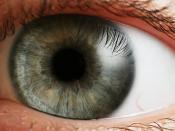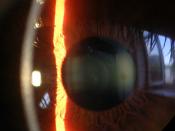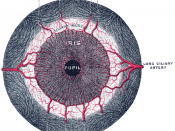Eye See It
In this essay I will outline the process in which light goes through to give humans their sight and how the eye is specialised in producing a clear image for the brain to interpret.
Conjunctiva, Cornea, Pupil (Iris), Retina, Blind Spot, Fovea (Yellow Spot)
The very first thing light will come into contact with will either be the eye lid if the eye is closed which will stop an image being produced at all or the conjunctiva which coats the cornea. The conjunctiva is a thin layer of transparent cells placed to protect the vulnerable soft cornea. All the light passes through the conjunctiva in normal cases and hits the cornea. The cornea is part of the sclera layer which coats the eye but is the only part of it that is transparent. The cornea plays a key part in the focusing of an image on the retina.
The cornea bends or refracts the light passing through it. This is the first stage in focusing the light ready for the retina. The cornea refracts the light because of it's curved surface but the degree of refraction is not variable. The pupil is not as such a thing as a hole. It's job is to control the amount of light that is allowed to pass on through to the lens. The process of change is a reflex action controlled by the autonomic nervous system and not controlled by us thinking as such. The pupil size is controlled by the muscles of the iris which surrounds the hole. There are two types of muscle controlling the iris. These are circular and radial. The circular muscles go in a circle around the iris wheras the radial muscles shoot out from the iris pulling agains the sclera. The...


